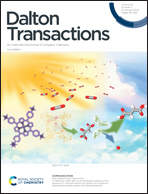Ion mobility mass spectrometry uncovers regioselectivity in the carboxylate-assisted C–H activation of palladium N-heterocyclic carbene complexes†
Abstract
Carboxylate-assisted Pd-catalyzed C–H bond activation constitutes a mild and versatile synthetic tool to efficiently and selectively cleave inert C–H bonds. Herein, we demonstrate a simple method to experimentally evaluate both reactivity and selectivity in such systems using mass spectrometry (MS) methods. The N-heterocyclic carbene (NHC) cations [(NHC)PdX]+, bearing as X− ligand bases commonly used to promote the C–H activation (carboxylates and bicarbonate), are generated in the gas-phase by ESI-MS. Their C–H bond activation at the N-bound groups of the NHC is then studied using Collision Induced Dissociation (CID) experiments. Ion Mobility Spectrometry (IM)-MS is exploited to identify a number of regioisomers associated with the distinctive site selective C–H activations. It is demonstrated that such C–H activation concomitant with acetic acid release occurs from a mixture of activated [(NHC-H)Pd(CH3CO2H)]+ and non-activated [(NHC)Pd(CH3CO2)]+ complexes. The identity of the X-type ligands (X = Cl−, carboxylates and bicarbonate) has a significant impact on the regioisomer branching ratio upon CID conditions. IM-MS in conjunction with a DFT mechanistic study is presented for the acetate-assisted C–H activation of the [(NHC)Pd(CH3CO2)]+ cation featuring butyl and aryl as N-donor groups.



 Please wait while we load your content...
Please wait while we load your content...